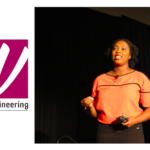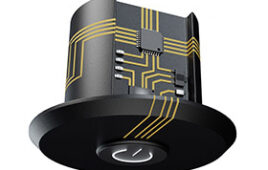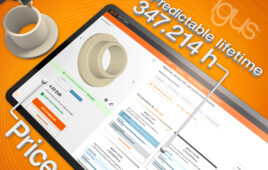Kimberly Gliebe is a chemical engineer currently working towards her materials science and engineering Ph.D. at Case Western Reserve University in Cleveland. We recently asked her six questions about her chosen career path. Here’s what she had to say.
What first drew you to engineering?
I think that it is hard to completely grasp what an engineer does, considering that the field and the work done by engineers are so vast. However, in high school I was aware that engineers solve tough problems. They often use science and math to devise those solutions, and they work at the forefront of technology. Also, it was important for me to incorporate my love of nature into my career. I have a deep value of our planet, and from what I understood of climate change as a teenager, I knew we had a major problem on our hands as a global population. I decided that I could contribute solutions to this problem via my career.
I thought that working on renewable energy technology, such as solar panels and batteries, would provide some solutions to this climate-change problem. As an engineer, I could design better products that would also be accessible to the greater society. Additionally, I found that engineering would be a career that would greatly challenge me, and I enjoy seeing how much potential I have.

Were there any influential engineers who helped shaped career choice?
I am lucky to have been surrounded by engineers growing up. My dad is an engineer, several of my uncles are engineers, and when my older sister went to college, she decided to be an engineer. Additionally, I had the opportunity in high school to do a science project with a scientific professional. The person I contacted is an assistant professor in chemistry at Case Western Reserve University. I was able to work on organic photovoltaics with her, and this made my dream of working with renewable energy technology seem attainable.
Another person who influenced me was a coach I had for forensics in Science Olympiad. He was a chemical engineer and let me shadow him for a week at Lubrizol.
These people allowed me to ask questions about their professions … and their answers helped me formulate an idea of what my future profession could look like in engineering.
Describe your involvement in a research or design project.
In my senior year of chemical engineering at the University of Dayton, I worked heavily with teams for several class projects. In the past, I’d always preferred to work individually rather than in groups — as I like to have a sense of the timeline of completion for a project and an organized set of tasks. I always thought that this would be complicated with a team, but I realized that the sense of organization that I have makes me a good leader.
Our senior project was to design a chemical manufacturing plant for a polymer that would be used to assist in the additive manufacturing of glass. Because it was such a complex project, it was helpful to break the project down into a set of tasks that needed to be completed and a timeline to complete them. With everyone in the team having a central direction and an idea of where to contribute, it made the workflow in a team very easy.
Describe your biggest research or engineering challenge to date.
When I was a senior in undergrad, along with having group projects for my classes, I was also working part-time at the Air Force Research Laboratory at Wright Patterson Air Force Base. I was put in charge of a project that required programming, use of specialized equipment, and advanced knowledge of materials science. I did not start the project with these skills, and I knew that I had less than a year to complete my work before continuing on to graduate school.
I am very grateful to have had so many people who were working full time at the Air Force Base to help me with my project. My collaborators could explain their specific set of knowledge and help me apply it to what was demanded of my project. In this way, I had access to a much wider arsenal of skills than if I worked alone. I learned new techniques and had additional time to focus on interpreting the results of my work.
What more can be done to promote greater participation of young women in engineering?
We need to lower the barriers to entry of STEM for girls as much as possible. Science and technology should be approachable, fun, and naturally suited to some of women’s strengths. We can make building Legos a social activity among girls. Girls can design web pages that reflect their current interests. Additionally, they need to see other women using science and technology in a variety of ways that are easy to understand and seem fun. Moms can play video games with their daughters. YouTube channels can explain the chemistry behind cooking. Girl Scouts can make ‘elephant toothpaste’ or build robots for competitions.
When I was growing up, seeking out STEM hobbies was not the status quo. But today we can change that by making STEM accessible through everyday people girls know (such as teachers and family) as well as cultural icons such as Disney stars and famous YouTubers.
What unique perspective do you think women bring to engineering?
If certain groups of people aren’t involved in major design- engineers projects, then end products of those projects may be unsuited to them. This is especially bad if leaving out half of the population — women who have very different bodies and experiences than men.
For instance, in the book, Invisible Women: exposing data bias in a world designed for men author Caroline Criado-Pérez explains how “cars have been designed using car-crash test dummies based on the average male and ‘when a woman is involved in a car crash, she is 47% more likely to be seriously injured than a man’” … if more women were involved in the standardization of car-safety tests, perhaps they’d insist on tests that would prevent these serious injuries to women.
Additionally, for projects that do not have gender-based solutions (such as cracking the Enigma code during World War II, for example) women may help provide answers to very difficult problems simply because our unique experiences and perspectives might lead to different ideas and solutions. This is well explained in the book, The Difference: How the Power of Diversity Creates Better Groups, Firms, Schools, and Societies by Scott Page. I would highly recommend both of these books to anyone who contributes to a business that designs products for consumers.
You may also like:
Filed Under: 3D printing • additive • stereolithography, Engineering Diversity & Inclusion








